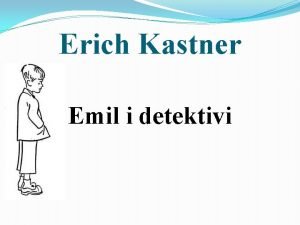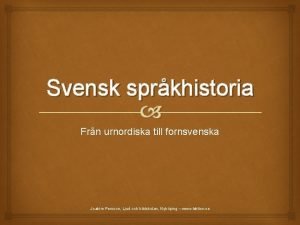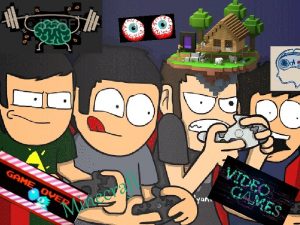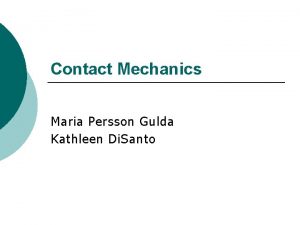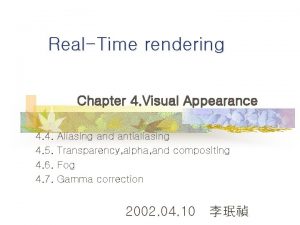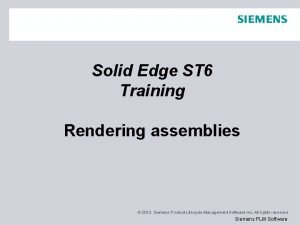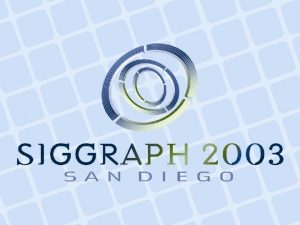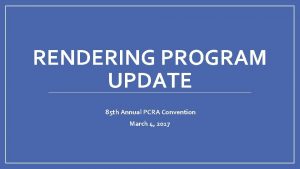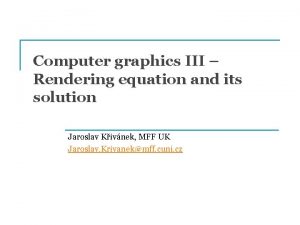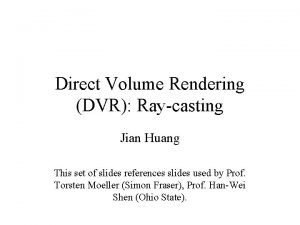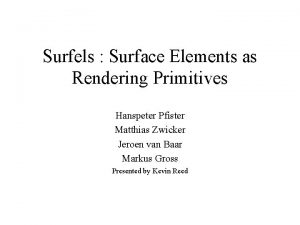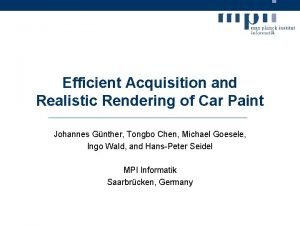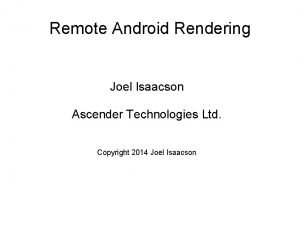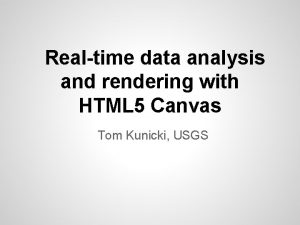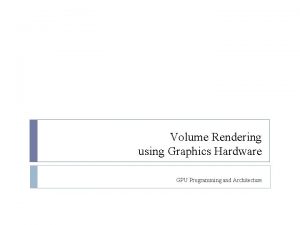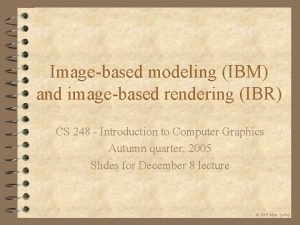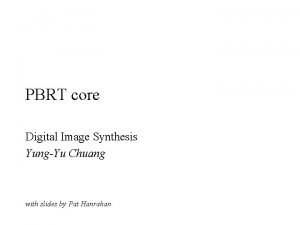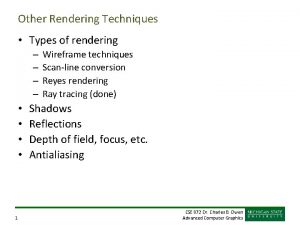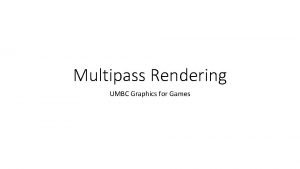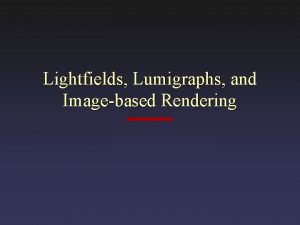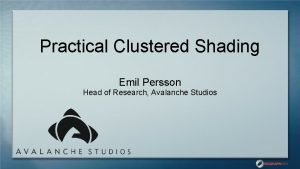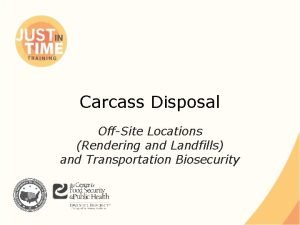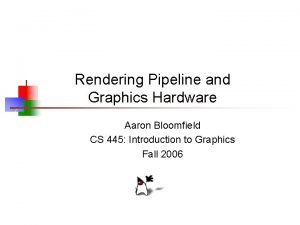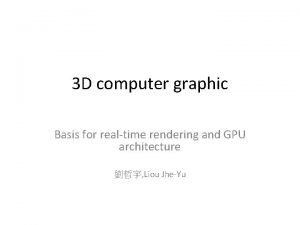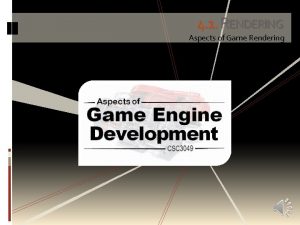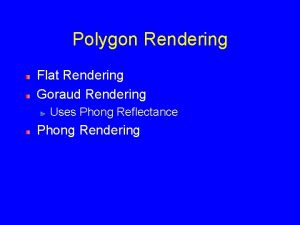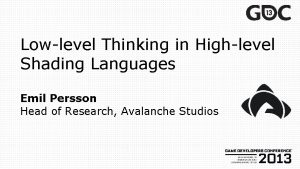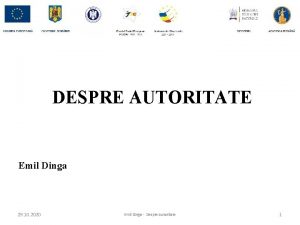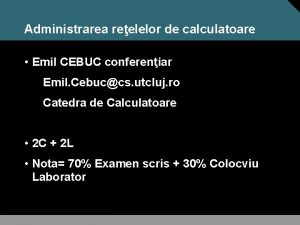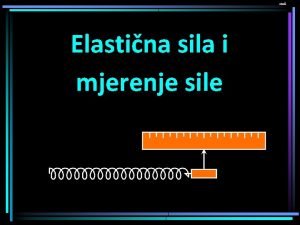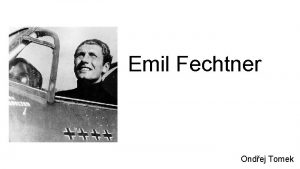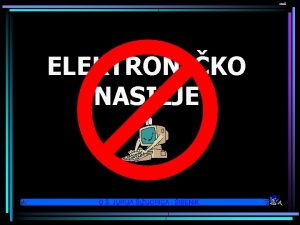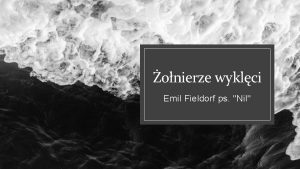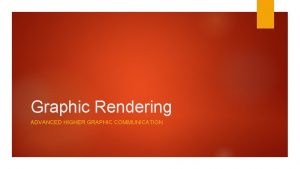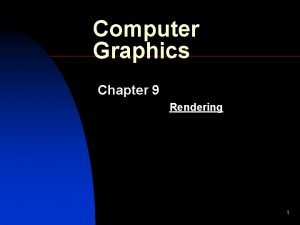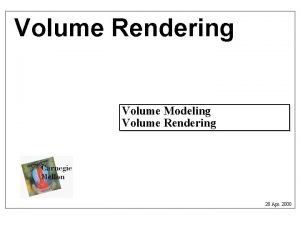Advanced D 3 D 10 Rendering Emil Persson





















![GS frustum and backface culling // Transform to clip space float 4 pos[3]; pos[0] GS frustum and backface culling // Transform to clip space float 4 pos[3]; pos[0]](https://slidetodoc.com/presentation_image_h/ed3a4aaa92d17880f0e318457819b6ca/image-22.jpg)



![The new shader compiler Use [branch], [flatten], [unroll] & [loop] to control output code The new shader compiler Use [branch], [flatten], [unroll] & [loop] to control output code](https://slidetodoc.com/presentation_image_h/ed3a4aaa92d17880f0e318457819b6ca/image-26.jpg)

- Slides: 27

Advanced D 3 D 10 Rendering Emil Persson May 24, 2007

Overview Introduction to D 3 D 10 Rendering techniques in D 3 D 10 Optimizations 2 May 24, 2007 Advanced D 3 D 10 Rendering

Introduction Best D 3 D revision yet! Clean and powerful API Lots of new features – SM 4. 0 New geometry shader Stream Out – – – – 3 Texture arrays Render to volume texture MSAA individual sample access Constant buffers Sampler state decoupled from texture unit Dual-source blending Etc… May 24, 2007 Advanced D 3 D 10 Rendering

Clean API Vista only Everything is mandatory (almost) – No legacy hardware support Clean starting point for future evolution of the API – Limited market short-term Some old features deprecated – – – 4 Fixed function Assembly shaders Alpha test Triangle fans Point sprites Clip planes May 24, 2007 Advanced D 3 D 10 Rendering

Dealing with deprecated features Fixed function – Write a few über-shaders Assembly shaders – Convert to HLSL Alpha test – Use discard or clip() in pixel shader – Use alpha-to-coverage Triangle fans – Seldom used anyway, usually just for a quad – Convert to triangle list or strip Point sprites – Expand point to 2 triangles in GS Clip planes – Use clip distance and/or cull distance 5 May 24, 2007 Advanced D 3 D 10 Rendering

SM 4. 0 Geometry shader – Processes a full primitive (point, line, triangle) – Has access to adjacency information (optional) Useful for silhouette detection, shadow volume extrusion etc. – May output multiple primitives Output limitation is 1024 floats – May output nothing (to kill primitive) 6 May 24, 2007 Advanced D 3 D 10 Rendering

SM 4. 0 Infinite instruction count – Very long shaders may have lower throughput though Integer and bitwise instruction Indexable temporaries – Allows for local arrays – May be used to emulate a stack Useful system generated values – SV_Vertex. ID – SV_Primitive. ID – SV_Instance. ID – SV_Position (Like VPOS, but now. zw are defined too) – SV_Is. Front. Face (Like VFACE) – SV_Render. Target. Array. Index – SV_Viewport. Array. Index – SV_Clip. Distance – SV_Cull. Distance 7 May 24, 2007 Advanced D 3 D 10 Rendering

SM 4. 0 Integer & bitwise instructions – Signed and unsigned No idiv though, just udiv – Same registers as floats Can alias without conversion with asint(), asuint(), asfloat() etc. – Integer texture sample values Syntax: Texture 2 D <uint 4> my. Tex; Access to individual samples in MSAA surface – Allows for custom AA resolve Syntax: Texture 2 DMS <float 4, 4> my. Tex; 8 May 24, 2007 Advanced D 3 D 10 Rendering

Pixel center Half pixel offset is gone! – Affects SV_Position as well – Now matches Open. GL DX 10 9 May 24, 2007 Advanced D 3 D 10 Rendering DX 9

Pixel center Pixels and texels align – Tex. Coord = SV_Position. xy / float 2(width, height) Texel center 10 May 24, 2007 Screenspace Advanced D 3 D 10 Rendering

The small batch problem D 3 D 10 designed to minimize batch overhead – Pulls work from draw time to creation time Validation Shader input/output configuration – Immutable State Objects Input layout Rasterizer state Sampler state Depth stencil state Blend state 11 May 24, 2007 Advanced D 3 D 10 Rendering

The small batch problem D 3 D 10 also provides tools to reduce draw calls – Improved instancing interface – Geometry shader – More shader resources – Constant indexing in PS – Render target arrays – Texture arrays 12 May 24, 2007 Advanced D 3 D 10 Rendering

Rendering techniques in D 3 D 10 13 May 24, 2007 Advanced D 3 D 10 Rendering

Global Illumination 14 May 24, 2007 Advanced D 3 D 10 Rendering

Global Illumination Probes on a volume grid across the scene – Each probe captures light environment into a tiny “cubemap” – Probes are converted to Spherical Harmonics coefficients Indirect lighting is computed using interpolated SH coefficients – Do the same in probe passes to get multiple light bounces 15 May 24, 2007 Advanced D 3 D 10 Rendering

Global Illumination Awful lot of work – Each probe is 6 slices. We need loads of probes. – Sample scene has over 300 probes Solution – Use geometry shader to reduce work – Distribute work across multiple frames Sample updates 40 cubes per frame Scatter updates to hide artifacts – Skip over “empty” space probes 16 May 24, 2007 Advanced D 3 D 10 Rendering

Global Illumination The Geometry Shader advantage – 40 cubes x 6 faces x n draw calls = Pain DX 9 style unrealistic even for simple scenes – Update multiple slices per pass with GS output limit is 1024 floats Keep number of interpolators down to maximize primitive count Managed to update 5 probes (30 slices) per pass 8 passes is more manageable than 240. . . 17 May 24, 2007 Advanced D 3 D 10 Rendering

Post tone-mapping resolve D 3 D 10 allows for custom AA resolves – Can drastically improve HDR AA quality Standard resolve occurs before tone-mapping Ideally resolve should be done after tone-mapping Standard resolve 18 May 24, 2007 Advanced D 3 D 10 Rendering Custom resolve

Post-tonemapping resolve Texture 2 DMS<float 4, SAMPLES> t. HDR; float 4 main(float 4 pos: SV_Position) : SV_Target { int 3 coord; coord. xy = (int 2) pos. xy; coord. z = 0; // Tone-map individual samples and sum it up float 4 sum = 0; [unroll] for (int i = 0; i < SAMPLES; i++) { float 4 c = t. HDR. Load(coord, i); sum. rgb += 1. 0 – exp 2(-exposure * c. rgb); } // Average sum *= (1. 0 / SAMPLES); // s. RGB sum. rgb = pow(sum. rgb, 1. 0 / 2. 2); return sum; } 19 May 24, 2007 Advanced D 3 D 10 Rendering

Optimizations 20 May 24, 2007 Advanced D 3 D 10 Rendering

Geometry shader GS optimizations – Input/output usually the bottleneck – Reduce outputs with frustum and/or backface culling – Keep input small by packing data Tex. Coord could be 2 x 16 bits in an uint – Or use for instance asuint(normal. w) Merge to full float 4 vectors – Don’t do 2 x float 2 – Keep output small Could be faster to trade for some work in PS Pass just position, don’t interpolate both light. Vec and view. Vec – Or even back-project SV_Position. xyz to world space in PS Small output means more work fits within 1024 floats limit 21 May 24, 2007 Advanced D 3 D 10 Rendering
![GS frustum and backface culling Transform to clip space float 4 pos3 pos0 GS frustum and backface culling // Transform to clip space float 4 pos[3]; pos[0]](https://slidetodoc.com/presentation_image_h/ed3a4aaa92d17880f0e318457819b6ca/image-22.jpg)
GS frustum and backface culling // Transform to clip space float 4 pos[3]; pos[0] = mul(mvp, In[0]. pos); pos[1] = mul(mvp, In[1]. pos); pos[2] = mul(mvp, In[2]. pos); // Use float 4 frustum culling to improve performance t 0 = saturate(pos[0]. xyxy * float 4(-1, 1, 1) - pos[0]. w); t 1 = saturate(pos[1]. xyxy * float 4(-1, 1, 1) - pos[1]. w); t 2 = saturate(pos[2]. xyxy * float 4(-1, 1, 1) - pos[2]. w); t = t 0 * t 1 * t 2; [branch] if (!any(t)) { // Use backface culling to improve performance float 2 d 0 = pos[1]. xy * pos[0]. w - pos[0]. xy * pos[1]. w; float 2 d 1 = pos[2]. xy * pos[0]. w - pos[0]. xy * pos[2]. w; [branch] if (d 1. x * d 0. y > d 0. x * d 1. y || min(pos[0]. w, pos[1]. w), pos[2]. w) < 0. 0) { // Output primitive here. . . } } 22 May 24, 2007 Advanced D 3 D 10 Rendering

Miscellaneous optimizations Pre-baked constant buffers – Don’t update per-material constants in DX 9 style PS don’t need to return float 4 anymore – Use float 3 if you only care about RGB – May reduce instruction count Use GS to reduce draw calls – Single pass render-to-cubemap – Update multiple render targets per pass 23 May 24, 2007 Advanced D 3 D 10 Rendering

The new shader compiler SM 4 shader compiler preserves semantics better – This means more responsibility for you guys – Be careful about your assumptions – Periodically check the resulting assembly D 3 D 10 Disassemble. Shader() Use GPUShader. Analyzer for performance critical shaders 24 May 24, 2007 Advanced D 3 D 10 Rendering

The new shader compiler Example: HLSL code: float 4 main(float 4 t: TEXCOORD 0) : SV_Target { if (t. x > t. y) return t. xyzw; else return t. wzyx; } DX 9 assembly: add r 0. x, -v 0. x, v 0. y cmp o. C 0, r 0. x, v 0. wzyx, v 0 DX 10 assembly: lt r 0. x, v 0. y, v 0. x if_nz r 0. x // <--- Did you really want a branch here? mov o 0. xyzw, v 0. xyzw ret else mov o 0. xyzw, v 0. wzyx ret endif 25 May 24, 2007 Advanced D 3 D 10 Rendering
![The new shader compiler Use branch flatten unroll loop to control output code The new shader compiler Use [branch], [flatten], [unroll] & [loop] to control output code](https://slidetodoc.com/presentation_image_h/ed3a4aaa92d17880f0e318457819b6ca/image-26.jpg)
The new shader compiler Use [branch], [flatten], [unroll] & [loop] to control output code – This is not for everyone – Poor use could reduce performance Make sure you know what you’re doing Only use if you’re familiar with assembly code Verify that you get the code you expect – Always benchmark both options New DX 10 assembly (using [flatten]): lt r 0. x, v 0. y, v 0. x movc o 0. xyzw, r 0. xxxx, v 0. xyzw, v 0. wzyx ret 26 May 24, 2007 Advanced D 3 D 10 Rendering

Questions? emil. persson@amd. com 27 May 24, 2007 Advanced D 3 D 10 Rendering
 Emil i detektivi
Emil i detektivi Joakim persson son
Joakim persson son Anders persson meteorology
Anders persson meteorology Markus persson fratello
Markus persson fratello Maria persson gulda
Maria persson gulda Visual rendering
Visual rendering Solid edge rendering
Solid edge rendering Image-based modeling
Image-based modeling Photorealistic rendering carlsbad
Photorealistic rendering carlsbad Kajiya rendering equation
Kajiya rendering equation Direct volume rendering ray casting
Direct volume rendering ray casting Blockinmax
Blockinmax Car paint rendering
Car paint rendering Vray back to beauty
Vray back to beauty Rendering
Rendering Rendering realtime compositing
Rendering realtime compositing Jerry tessendorf
Jerry tessendorf Graphics rendering
Graphics rendering Rendering equation
Rendering equation Types of rendering techniques
Types of rendering techniques Multipass rendering
Multipass rendering Lumigraph rendering
Lumigraph rendering Clustered forward rendering
Clustered forward rendering Morgan kauffman
Morgan kauffman Rendering carcass
Rendering carcass Rendering pipeline
Rendering pipeline Windowscolorsystem
Windowscolorsystem Real time rendering architecture
Real time rendering architecture
